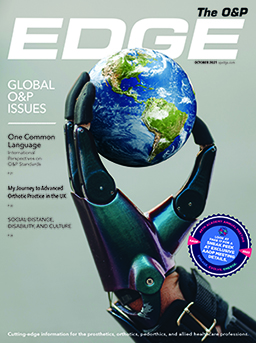Save $$ by Fabricating a One-Shot Socket Lamination with a Shuttle Lock

How many of you out there fabricate a double lamination when using a shuttle lock and a 4-hole plate? If you said, "I do," I would like to share a technique that could save you 50 percent in time and materials.
Using its sealed lock, Coyote Designs, Twin Falls, Idaho, developed a one-shot lamination utilizing a 4-hole plate. The lock is glued to the 4-hole plate in proper alignment, using urethane glue.
Scott Wimberley, a technician from Cornerstone Prosthetics and Orthotics, Everett, Washington, used what he learned from Coyote Designs and developed a one-shot lamination using the shuttle lock that he commonly uses in his facility, the IRS-200. David Hughes, CPO, owner of Cornerstone P&O, says that this technique saved over $10,000 dollars in time and materials in one year.
 |
| Figure 1 |
Here is Wimberley's technique:
- First prep the check socket for transfer in alignment fixture.
- Make a tool for filing the check socket, using an old attachment screw and a white plate that goes on the distal end of the plaster model. This will give you the exact placement on the distal end of the plaster model after the check socket is poured.
- Make sure to lubricate the distal end of the white attachment piece before you place it into the shuttle lock.
- Fill the check socket in proper alignment in the alignment fixture.
- Heat in the oven or use a heat gun and place in the socket
puller (Cornerstone uses Coyote Designs' socket puller). Using a
socket puller allows the patient to use the check socket while you
fabricate the definitive socket.

Figure 2 - You will need a few components before you go any further:
4-hole plate with center hole
polypro spacer with 4-hole pattern
4-hole female or male adaptor
4 attachment screws
Assemble as shown in picture. The plastic spacer allows for the thickness of the lamination.
The IRS-200 comes with two screws, which you will use.
You will need to get some 3/8" ID poly tubing
(you can get this at any local hardware store). - After attaching the shuttle lock to the positive model, place some clay on the head of the short screw.
- Place the positive model back into the alignment fixture. Place
the 4-hole plate, spacer, and adaptor on the footplate section of
the alignment fixture. Now you are ready to weld the shuttle lock
to the 4-hole plate, using urethane glue.

Figure 3 - After you have glued the shuttle lock to the 4-hole plate, pull it out of the alignment fixture and mark the alignment of the lock to the model.
- Now you need to take an IRS-200 and place it on a flat surface
with the distal side facing up. Insert the long attachment screw
into the shuttle lock as pictured. Now measure and cut a piece of
poly tubing to the height of the bottom of the head of the
attachment screw. This will allow you to use a full pin.

Figure 4 - After the glue is cured (about two minutes), remove from the alignment fixture and take the glued shuttle lock off the positive model. Remove the plastic spacer and insert four set screws at 1/4" above the plate. Make sure that you fill the four screws with clay and lubricate with Vaseline. Fill the inside of shuttle lock with DC-4 silicone. Insert the poly tubing and the long screw.
- Pull your inner PVA bag and cap and reattach the shuttle lock with welded 4-hole plate to the positive model.
- Lay up per your lamination standards for your patient's height,
weight and activity level, pull the outer bag, and laminate as
usual.

Figure 5 - After the lamination is cured, pull out the poly tubing and grind down to the four set screws and remove them. This will give you a flat surface for attaching the pyramid.
I would like to thank Scott Wimberley for sharing this system with all of us. Sharing tips and techniques through this forum only makes us stronger technicians. So please feel free to share your advanced techniques with us. Together we can grow stronger!
View the PowerPoint Presentation on the one-shot
system.
For more information about Coyote Designs, visit www.coyotedesign.ws or call 800.819.5980;
e-mail: sales@coyotedesign.ws
 |
| Figure 6 |
 |
| Figure 7 |
 |
| Figure 8 |






-
-
-
-
CONTACT US